- Call +84 981 237 915 Or Email
- info@nadovatours.com
The Geography of Vietnamese Noodle
Across Vietnam, noodles are a staple. But how they’re prepared and what they’re served with varies according to the climate, history and personality of each region
What’s better than the moment when you receive a steaming, aromatic bowl of noodles? Is it when you add the garnishes and that squeeze of lime that somehow always ends up on your face? Or is it that blissful moment when you finally get to eat the noodles, when it’s just you and the noodles and no one else?
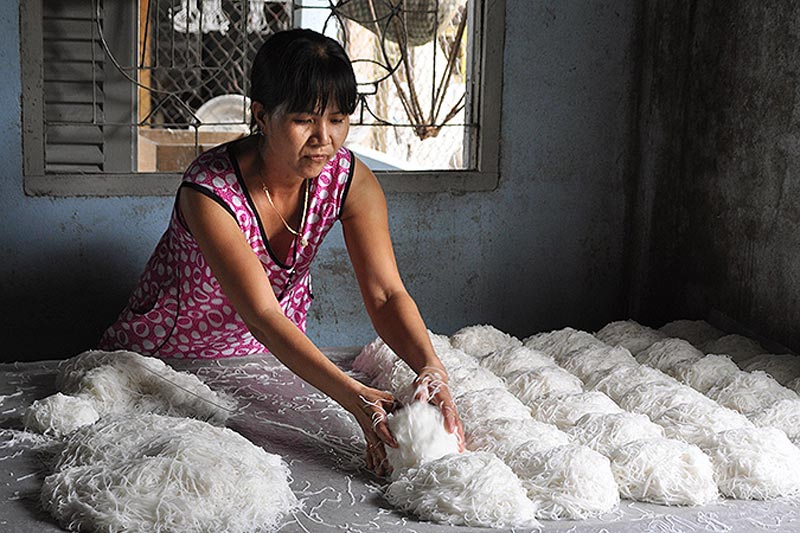 The noodle maker
The noodle maker
In Vietnam, noodles are the thread of daily life. From flat rice noodles (bánh phở) in the morning to rice vermicelli (bún) in the afternoon, from rolled noodle sheets (bánh cuốn) as a quick street snack to thick, plump cylindrical noodles (bánh canh) at the end of the night, all kinds of noodles are enjoyed as a staple. But how they’re prepared and what they’re paired with varies greatly, and often depends on what’s available within the various regions of the S-shaped country.
In the cooler north along the Chinese border, people tend to eat simpler meals with purer broths. They’re not as flamboyant with herbs, condiments and garnishes like those of the tropical south where vegetation is in abundance. Northerners prefer their food either salty or plain; southerners prefer it sweet and vivacious; and those from the center love it hot, zesty and peppery.
THE NORTH: HANOI
Beef pho was first created during the French colonial period as a Vietnamese interpretation of beef casserole
The world-famous phở bò (beef pho) is actually an interpretation of a French dish. Legend has it that during French colonial times (1887-1954), a street vendor just outside of Hà Nội was one of the first to gather discarded marrow-rich bones, cartilage-rich oxtail and other undesirable cuts of beef. He poached them with a concoction of spices left by the Chinese (cloves, star anise, black cardamom), essentially creating a watered-down beef casserole. But being Vietnamese, not French, he had to have it with noodles.
When the communists ruled the north after the revolution in 1954, many northerners fled south and brought the much-loved phở with them. In the south, where the land was much more fertile and the people loved to be extravagant with flavor, phở changed drastically and developed its own signature depending on where it was prepared. Southerners also like their bánh phở noodles much thinner and with more of a bite—thinner noodles let more air circulate, thus making the slurp of broth or sauce more indulgent and satisfying.
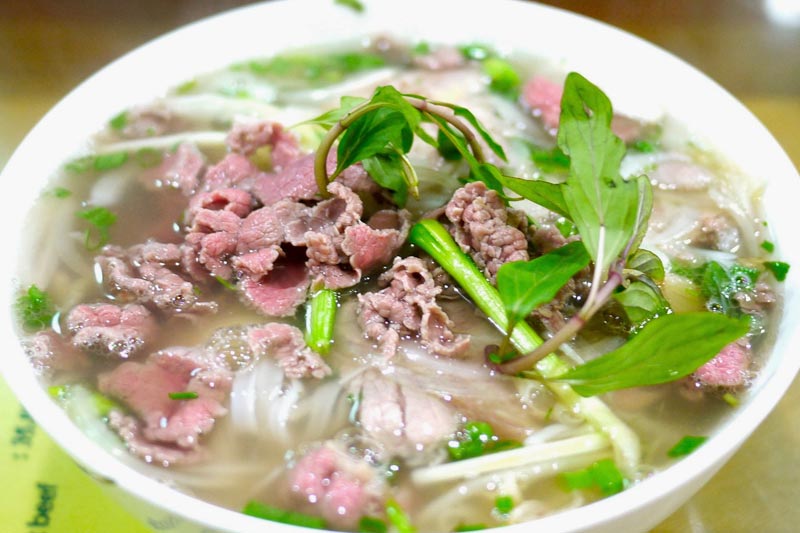 Pho Bo Hanoi
Pho Bo Hanoi
THE CENTER: HUẾ
The Central city of Huế was once the capital and is still brimming with history from its past dynasties. Here, food is meticulously prepared although the people are generally poorer and tend to make do with whatever ingredients they can get their hands on. Bún bò Huế is a famous and delicious breakfast bowl of lemongrass beef and pork noodle soup that’s served with the fattest rice vermicelli—sometimes measuring more than 1.8mm. Somehow it only tastes right with thicker noodles, which were meant to keep Huế residents fuller for longer.
In the mid-morning, afternoon or after supper, bánh canh cá lóc is a popular local snack. This humble but mouthwatering lemongrass and marrow-rich snakehead fish (similar to catfish) soup comes with hand-rolled noodles and plenty of herbs, heat and zest. Soups in this region are often served with unpeeled, whole quail eggs and chả Huế—a famous and much sought-after paste of cinnamon, pepper and steamed pork wrapped in a banana leaf.
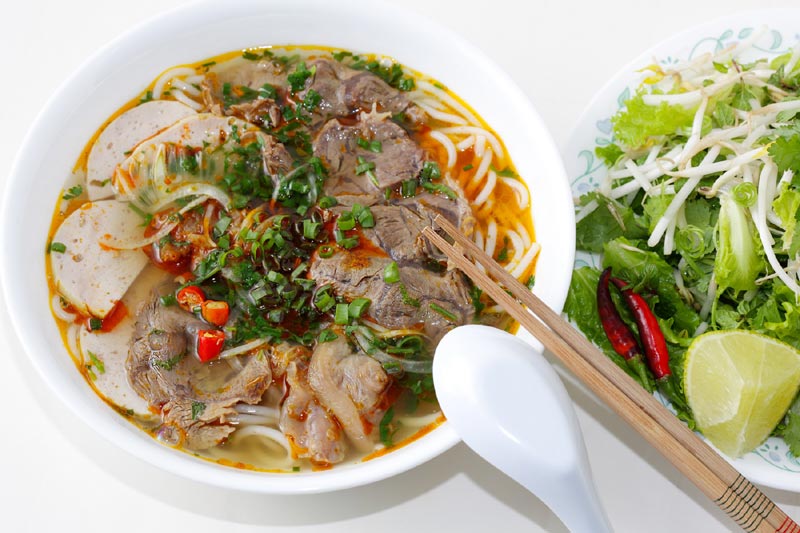 Bun Bo Hue
Bun Bo Hue
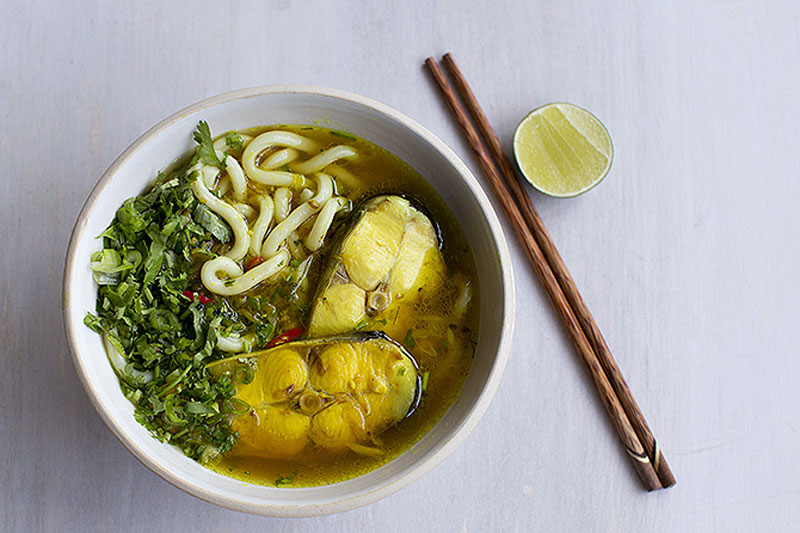 Banh Canh Ca Loc Hue
Banh Canh Ca Loc Hue
COASTAL TOWNS: PHAN THIẾT
Drive down the coast from Huế to the southerly fish-sauce-making seaside town of Phan Thiết (my mother’s hometown) and the food takes on its own quirky personality. Instead of adding rice vermicelli to summer rolls, locals add shredded pork skin coated in roasted rice powder, which mimics noodles in its appearance and (slightly chewy) texture.
The famous street noodle soup bánh canh Phan Thiết is a great top-up after an evening meal, designed to keep hunger at bay and make for a sound sleep. The broth is either made from pork knuckles and trotters or with fish or crab, and is served with pork or dill fish cakes plus an array of seafood and condiments. It is wonderfully sweet and fresh with lime and fierce with chilies too. The dish is usually slurped from a spoon because its short, thick and transparent hand-rolled tapioca noodles fit right into it.
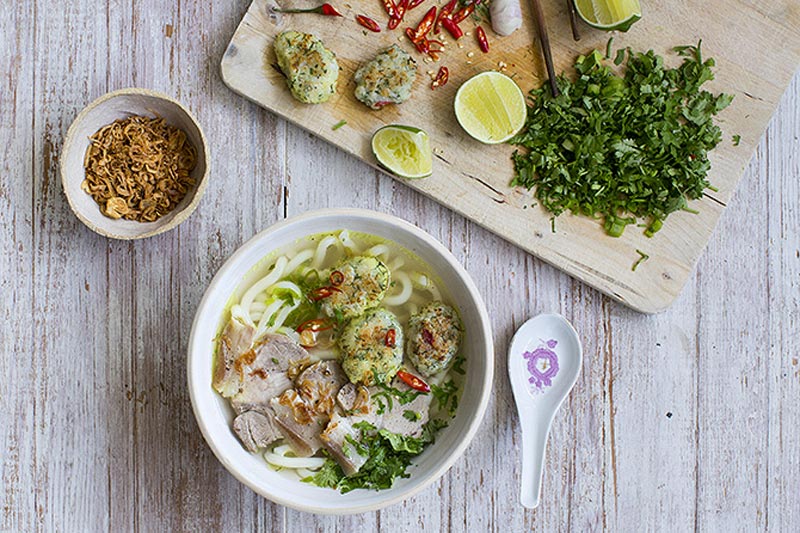 Banh Canh Phan Thiet
Banh Canh Phan Thiet
THE SOUTH: SÀI GÒN (HO CHI MINH CITY)
The Sai-Gonese prefer the non-noodle components of a dish to shine—like a piece of grilled pork, caramelized by sweet sticky sugar and smoked over charcoal with savory, pungent fish sauce. The treacle aroma of bún thịt nướng (rice noodles with chargrilled meat) hovers around Sài Gòn every afternoon as skewer after skewer sizzles then drops onto bowls of fresh fluffy bún. They are then layered with an abundance of herbs such as perilla, mint and coriander, which are used with an assortment of salad leaves and crunchy pickles for color and garnish. Finally, nước chấm: that ultimate dressing of sweet, sour, salty and hot fish sauce that makes this noodle dish the supreme fast food of Sài Gòn.
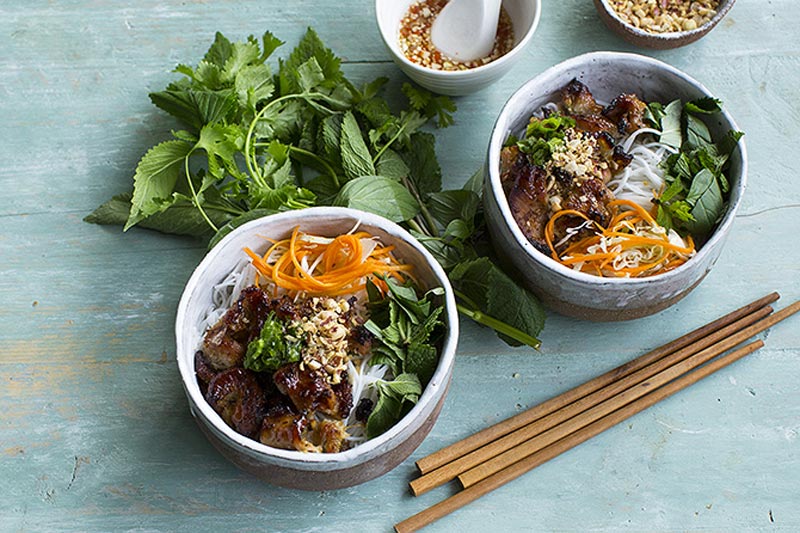 Bun Thit Nuong Sai Gon
Bun Thit Nuong Sai Gon
No matter where you are in the country, noodles are here, there and everywhere. In a rapidly developing world, where fast food is infiltrating from the West, Vietnamese cuisine is still very much cherished by its people: from those in the rice paddies to those in the high-rise cities and seaside resorts. Not only are noodles vital to the diet, the dishes made with them represent place, celebrate culture and preserve tradition.
Source: momentum.travel
View Tour: Vietnam Food Tour For Family 17 days
Recent Posts
- Ultimate First-Timer’s Guide to Vietnam: Essential Tips You Must Know Before You Go
- 10 Compelling Reasons Why Vietnam Will Be Southeast Asia’s Top Travel Destination in 2026
- Travel to Vietnam from Australia: Everything You Should Know
- Chasing the Winter Sun: The Best Beaches to Visit in Vietnam This December
- Hoa Lo Prison – A Glimpse into Hanoi’s Living History
Recent articles
- Ultimate First-Timer’s Guide to Vietnam: Essential Tips You Must Know Before You Go
- 10 Compelling Reasons Why Vietnam Will Be Southeast Asia’s Top Travel Destination in 2026
- Travel to Vietnam from Australia: Everything You Should Know
- Chasing the Winter Sun: The Best Beaches to Visit in Vietnam This December
- Hoa Lo Prison – A Glimpse into Hanoi’s Living History
- Cu Chi Tunnels: Step Inside Vietnam’s Underground World
- Main Principles of Vietnamese Food You Should Know
- Is It Safe to Travel to Vietnam in 2025? A Complete Safety Guide for Travelers
- Exploring Life on Cambodia’s Floating Villages of Tonle Sap Lake
- Top 5 Street Food Dishes in Hue Imperial City
Tags
Support Online

Being the locals, we know the true value of our land. We always listen and arrange everything as your desire. Please kindly send us whatever about your trip, we will send you best offers quickly.





